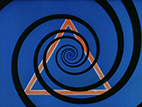Synchromy No. 4, Escape
- Unseen Cinema Collection |
- 1937-1938 |
- 5 minutes |
- COLOR |
- SOUND
Rental Format(s): Digital File
Alternate title: Synchromy No. 4, Toccata and Fugue.
Co-makers: Mary Ellen Bute, Theodore Nemeth. Assisted by William Nemeth.
Production: Expanding Cinema
Original format: 35mm sound film 1.37:1
Music: Johann Sebastian Bach - "Toccata from Toccata and Fugue (in D Minor)"
Transcribed by Leopold Stokowski. Performed by Leopold Stokowski and the Philadelphia Orchestra
Courtesy Mary Ellen Bute, Theodore Nemeth
Mary Ellen Bute's first color film tells a story in abstraction of an orange/red triangle imprisoned behind a grid of vertical and horizontal lines under a sky-blue expanse, perhaps representing freedom. J.S. Bach's Toccata and Fuge in D Minor adds dramatic tension to the visual variables in motion. -Cecile Starr
This new medium of expression is the Absolute Film. Here the artist creates a world of color, form, movement, and sound in which the elements are in a state of controllable flux, the two materials (visual and aural) being subject to any conceivable interrelation and modification. -Mary Ellen Bute
Infatuated with the new non-objective paintings of Kandinsky and others, Texas debutante Mary Ellen Bute (1906-1983) devoted twenty years (1932-1952) to creating thirteen abstract motion pictures in black-and-white and color, with familiar classical music accompaniments. Many were shown at New York's Radio City Music Hall. In 1966, she made a feature based upon James Joyce, Passages from Finnegan's Wake. -Cecile Starr
Before filming Mary Ellen Bute's short abstract films (1931-1953), Theodore "Ted" J. Nemeth (1911-1986) learned his craft creating special effects for feature film "trailers." As head of his own New York studio, founded in 1940 the year Bute and he were married, he made documentaries, commercials, and short subjects, two of which were Academy Award nominees. -Aram Boyajian





